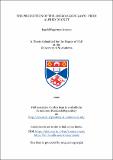Files in this item
The production of the Anglo-Saxon laws : from Alfred to Cnut
Item metadata
| dc.contributor.advisor | Humfress, Caroline | |
| dc.contributor.advisor | Hudson, John | |
| dc.contributor.author | Ivarsen, Ingrid | |
| dc.coverage.spatial | 219 p. | en_US |
| dc.date.accessioned | 2020-07-20T15:41:29Z | |
| dc.date.available | 2020-07-20T15:41:29Z | |
| dc.date.issued | 2020-07-30 | |
| dc.identifier.uri | https://hdl.handle.net/10023/20295 | |
| dc.description.abstract | This thesis examines the production of written law in Anglo-Saxon England by asking some basic questions. What is ‘an Anglo-Saxon law’? Where and when were surviving laws made? Who wrote them? What characterizes the laws as texts? These questions are answered using the laws’ language, text and form as evidence. In the first part of the thesis, I argue that the modern idea of what makes ‘an Anglo-Saxon law’ is adopted from editions, specifically Felix Liebermann’s 1903 Die Gesetze der Angelsachsen. I show that the corpus presented in this edition is not just a product of Liebermann’s own political, academic and legal contexts, but also those of his editorial predecessors. By relying on such a corpus we have constructed our view of Anglo-Saxon law and legislation on unstable foundations. Therefore, I offer a new corpus of laws and set out the criteria for texts’ inclusion. I also propose a new way in which to categorize surviving legislation, arguing that there are two main categories: law codes and decrees. The second half of the thesis examines the production of the texts belonging to each of these categories. A key finding is that not all laws were produced in the same way. Some texts fit into the traditional model for the production of legislation, namely that it was done in relation to meetings between the king and witan. Some surviving texts may even be records of oral assembly proceedings. However, other texts appear to have been produced outwith an assembly context, including some that must have been made through long processes of research, compilation and juridical thinking. The evidence provided by language, text and form thus suggests that the production of Anglo-Saxon law was flexible and that the relationship between writing and law was complex and varied. | en_US |
| dc.language.iso | en | en_US |
| dc.publisher | University of St Andrews | |
| dc.subject | Law | en_US |
| dc.subject | Anglo-Saxon history | en_US |
| dc.subject.lcc | KD554.I8 | |
| dc.subject.lcsh | Law, Anglo-Saxon | en |
| dc.subject.lcsh | Justice, Administration of--England--History--To 1500 | en |
| dc.subject.lcsh | Great Britain--History--Anglo-Saxon period, 449-1066 | en |
| dc.title | The production of the Anglo-Saxon laws : from Alfred to Cnut | en_US |
| dc.type | Thesis | en_US |
| dc.contributor.sponsor | University of London. Institute of Historical Research | en_US |
| dc.contributor.sponsor | University of St Andrews. St Leonard's College | en_US |
| dc.contributor.sponsor | University of St Andrews. Institute of Legal and Constitutional Research | en_US |
| dc.type.qualificationlevel | Doctoral | en_US |
| dc.type.qualificationname | PhD Doctor of Philosophy | en_US |
| dc.publisher.institution | The University of St Andrews | en_US |
| dc.identifier.doi | https://doi.org/10.17630/10023-20295 |
This item appears in the following Collection(s)
Items in the St Andrews Research Repository are protected by copyright, with all rights reserved, unless otherwise indicated.

